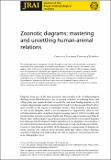Files in this item
Zoonotic diagrams : mastering and unsettling human-animal relations
Item metadata
| dc.contributor.author | Lynteris, Christos | |
| dc.date.accessioned | 2017-10-05T15:30:15Z | |
| dc.date.available | 2017-10-05T15:30:15Z | |
| dc.date.issued | 2017-09 | |
| dc.identifier.citation | Lynteris , C 2017 , ' Zoonotic diagrams : mastering and unsettling human-animal relations ' , Journal of the Royal Anthropological Institute , vol. 23 , no. 3 , pp. 463-485 . https://doi.org/10.1111/1467-9655.12649 | en |
| dc.identifier.issn | 1467-9655 | |
| dc.identifier.other | PURE: 251291228 | |
| dc.identifier.other | PURE UUID: c7cf50dd-2bf7-42ad-970f-2c9d31dc07c0 | |
| dc.identifier.other | Bibtex: urn:81c93cceef0ba6edfdc22d2656a716e5 | |
| dc.identifier.other | ORCID: /0000-0001-8397-0050/work/60630738 | |
| dc.identifier.other | WOS: 000407272700001 | |
| dc.identifier.other | Scopus: 85021794758 | |
| dc.identifier.uri | https://hdl.handle.net/10023/11808 | |
| dc.description | Research leading to this article was funded by a European Research Council Starting Grant (under the European Union’s Seventh Framework Programme ERC grant agreement no. 336564) for the project ‘Visual Representations of the Third Plague Pandemic’ at the Centre for Research in the Arts, Social Sciences and Humanities of the University of Cambridge. | en |
| dc.description.abstract | This article approaches interspecies relations through an examination of the prevalent visual device employed in the representation of animal-human infection in the life sciences: the zoonotic cycles diagram. After charting its emergence and development in the context of bubonic plague, I explore how this diagrammatic regime has been applied in two distinct practical contexts: a plague warning sign on the Grand Canyon National Park hiking trail; and the on-line public information campaign launched by the US Centers for Disease Control and Prevention (CDC) in the wake of the Ebola outbreak of 2014-16. The article demonstrates the principal ontological and biopolitical operations of these diagrams, arguing that, far from simply summarizing epidemiological narratives of animal-human infection, they function both as pilots of human mastery over human-animal relations and as crucial sites of unsettlement for the latter. | |
| dc.format.extent | 23 | |
| dc.language.iso | eng | |
| dc.relation.ispartof | Journal of the Royal Anthropological Institute | en |
| dc.rights | © 2017 The Authors. Journal of the Royal Anthropological Institute published by John Wiley & Sons Ltd on behalf of Royal Anthropological Institute. This is an open access article under the terms of the Creative Commons Attribution-NonCommercial-NoDerivs License, which permits use and distribution in any medium, provided the original work is properly cited, the use is non-commercial and no modifications or adaptations are made. | en |
| dc.subject | GN Anthropology | en |
| dc.subject | QL Zoology | en |
| dc.subject | H Social Sciences | en |
| dc.subject | T-NDAS | en |
| dc.subject | BDC | en |
| dc.subject | SDG 3 - Good Health and Well-being | en |
| dc.subject.lcc | GN | en |
| dc.subject.lcc | QL | en |
| dc.subject.lcc | H | en |
| dc.title | Zoonotic diagrams : mastering and unsettling human-animal relations | en |
| dc.type | Journal article | en |
| dc.contributor.sponsor | European Research Council | en |
| dc.description.version | Publisher PDF | en |
| dc.contributor.institution | University of St Andrews. Social Anthropology | en |
| dc.identifier.doi | https://doi.org/10.1111/1467-9655.12649 | |
| dc.description.status | Peer reviewed | en |
| dc.identifier.grantnumber | 336564 | en |
This item appears in the following Collection(s)
Items in the St Andrews Research Repository are protected by copyright, with all rights reserved, unless otherwise indicated.

